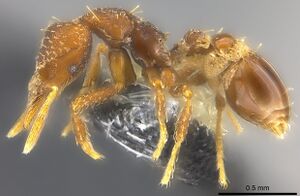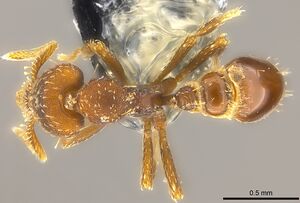Strumigenys trauma
| Strumigenys trauma | |
|---|---|

| |
| Scientific classification | |
| Kingdom: | Animalia |
| Phylum: | Arthropoda |
| Class: | Insecta |
| Order: | Hymenoptera |
| Family: | Formicidae |
| Subfamily: | Myrmicinae |
| Tribe: | Attini |
| Genus: | Strumigenys |
| Species: | S. trauma |
| Binomial name | |
| Strumigenys trauma (Bolton, 2000) | |
Specimens have been noted as being from rainforest and primary forest litter-samples.
Identification
Bolton (2000) - A member of the Strumigenys capitata-group. Presently known only from the Fiji Islands this small species (HW < 0.50) is related to Strumigenys charybdis, Strumigenys epipola, Strumigenys phasma, Strumigenys tethys and Strumigenys themis. Strumigenys trauma has only a single pair of standing hairs in front of the occipital margin (as opposed to a transverse row of 4 hairs), and its humeral hairs are very long. It has only a single pair of mesonotal standing hairs and has a very broad postpetiole. In addition its mandibles are relatively long (MI 26-27), an index matched in the complex only by themis (MI 25-29); others are shorter (MI collectively 19-24). Apart from these features it lacks characters diagnostic of other species in the complex: charybdis has much more extensive lateral petiolar lobes and a broad propodeal infradental lamella; epipola has a broader head and is lighter in colour; phasma has a uniquely shaped alitrunk and CI > 90; tethys has costulate sculpture laterally on the pronotum and on the metapleuron and propodeal side; themis is yellow with a narrow postpetiole and broader head (CI 85-89).
Keys including this Species
Distribution
Latitudinal Distribution Pattern
Latitudinal Range: -17.8° to -19.05°.
| North Temperate |
North Subtropical |
Tropical | South Subtropical |
South Temperate |
- Source: AntMaps
Distribution based on Regional Taxon Lists
Indo-Australian Region: Fiji (type locality).
Distribution based on AntMaps
Distribution based on AntWeb specimens
Check data from AntWeb
Countries Occupied
| Number of countries occupied by this species based on AntWiki Regional Taxon Lists. In general, fewer countries occupied indicates a narrower range, while more countries indicates a more widespread species. |

|
Estimated Abundance
| Relative abundance based on number of AntMaps records per species (this species within the purple bar). Fewer records (to the left) indicates a less abundant/encountered species while more records (to the right) indicates more abundant/encountered species. |

|
Biology
Castes
Images from AntWeb
   
| |
| Not Provided. Worker. Specimen code casent0184729. Photographer Eli M. Sarnat, uploaded by California Academy of Sciences. | Owned by EPEC. |
Nomenclature
The following information is derived from Barry Bolton's Online Catalogue of the Ants of the World.
- trauma. Pyramica trauma Bolton, 2000: 408 (w.) FIJI IS. Combination in Strumigenys: Baroni Urbani & De Andrade, 2007: 129
Unless otherwise noted the text for the remainder of this section is reported from the publication that includes the original description.
Description
Worker
Holotype. TL 2.2, HL 0.60, HW 0.48, CI 80, ML 0.16, MI 27, SL 0.28, SI 58, PW 0.31, AL 0.62. Apicoscrobal hair stout, weakly remiform and truncated apically. Dorsum of head with a pair of standing hairs in front of the occipital margin and another pair just in front of highest point of vertex. Pronotal humeral hair stout but elongate and simple, only very feebly curved and very much longer than the single pair of stout standing hairs that occur on the mesonotum. Petiole with a single pair of stout hairs, postpetiole with 3 pairs. Alitrunk mostly reticulate-punctate but pleurae and side of propodeum smooth. Petiole node in dorsal view reticulate-punctate, broader than long and roughly transversely rectangular. Disc of postpetiole in dorsal view voluminous and about twice broader than the petiole node; lateral margins of disc shallowly convex, not strongly convergent behind the midlength. Lateral and ventral spongiform appendages of petiole and postpetiole well developed.
Paratype. TL 2.2, HL 0.62, HW 0.49, CI 79, ML 0.16, MI 26, SL 0.28, SI 57, PW 0.32, AL 0.62.
Type Material
Holotype worker, Fiji Is: Kadavu, Mt Korogatule, nr Matasawalevu, 18°59'S, 178°28'E, 4.vii.1987, 300 m., rainforest sieved litter, QM Berlesate No. 773 (G. Monteith) (Australian National Insect Collection).
Paratype. 1 worker with same data as holotype (The Natural History Museum).
- Holotype, worker, Mt. Korogatule, near Matasawalevu, Kadavu, Fiji, Monteith,G., ANIC32-017701, Australian National Insect Collection.
References
- Baroni Urbani, C. & De Andrade, M.L. 2007. The ant tribe Dacetini: limits and constituent genera, with descriptions of new species. Annali del Museo Civico di Storia Naturale “G. Doria” 99:1-191.
- Bolton, B. 2000. The ant tribe Dacetini. Memoirs of the American Entomological Institute. 65:1-1028. (page 408, worker described)
- Liu, C., Sarnat, E.M., Friedman, N.R., Hita Garcia, F., Darwell, C., Booher, D., Kubota, Y., Mikheyev, A.S., Economo, E.P. 2020. Colonize, radiate, decline: Unraveling the dynamics of island community assembly with Fijian trap‐jaw ants. Evolution 74, 1082–1097 (doi:10.1111/EVO.13983).
- Sarnat, E.M., Hita-Garcia, F., Dudley, K., Liu, C., Fischer, G., Economo, E.P. 2019. Ready species one: Exploring the use of augmented reality to enhance systematic biology with a revision of Fijian Strumigenys (Hymenoptera: Formicidae). Insect Systematics and Diversity 3(6): 6; 1–43 (doi:10.1093/isd/ixz005).
References based on Global Ant Biodiversity Informatics
- Bolton, B. 2000. The Ant Tribe Dacetini. Memoirs of the American Entomological Institute 65
- CSIRO Collection
- Sarnat Eli M. 2009. The Ants [Hymenoptera: Formicdiae] of Fiji: Systematics, Biogeography and Conservation of an Island Arc Fauna. 80-252
- Ward, Darren F. and James K. Wetterer. 2006. Checklist of the Ants of Fiji. Fiji Arthropods III 85: 23-47.

